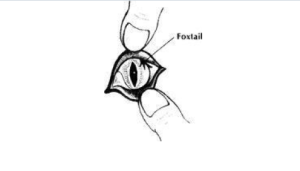The Classic Comprehensive Handbook of Cat Care
What to Do When Your Cat Is Sick: TRAUMA TO OR FOREIGN OBJECT IN THE EYE
Epiphora and conjunctivitis may be signs of a foreign body in the eye or eye injury due to trauma. So it’s a good idea to examine your cat’s eye thoroughly whenever there are such signs. If epiphora and/or conjunctivitis are unilateral (on one side) only, are accompanied by squinting, pawing at the eye, or other signs of pain, a thorough examination for a foreign body or eye injury must be made.
The first thing to do when examining your cat’s eye is to get in a good light. Slight but extremely important changes in the eye are easily overlooked in dim light. Place the thumb of one hand just below the edge of the lower lid of the affected eye and the thumb of the opposite hand just above the edge of the upper lid. This rolls the lids away from the eyeball, allowing examination of the conjunctiva and most of the cornea. The surface of the cornea should look smooth and completely transparent. (If in doubt, compare it to the opposite, probably uninjured, eye.) Be sure to look along the edge of the third eyelid to see if there is anything protruding from behind it. It is a good idea to look under the third eyelid, but most cats with a painful eye will not allow you to lift this eyelid without some form of anesthesia. You can, however, moisten a cotton-tipped swab and move it gently along the inner surface of the lids and under the third eyelid.
Occasionally a foreign body will cling to the swab and be removed, or the swab will sometimes bring a hidden foreign body into view. This must be done with extreme care to avoid injury to the cornea and should be attempted at home with only the most cooperative cat to avoid damage to both you and the pet. If you see a large object (e.g., foxtail), you can grasp it with your fingertips or a pair of tweezers and remove it. Small foreign bodies are most easily removed with a moistened cotton swab or a piece of tissue. Any foreign object not easily removed should be entrusted to a veterinarian, and any sign of irritation that persists more than a few hours following foreign body removal is reason to have the eye examined by an expert.
EXAMINING THE EYE FOR FOREIGN OBJECT
In most cases of foreign body in the eye or trauma to the eye examination is best performed by a veterinarian. Since a cat can’t tell you when there is eye irritation, it is often easy to overlook small but significant eye damage. Veterinarians use special eye stains to color the surface of the cornea. These stains show the presence of corneal damage not otherwise evident. Veterinarians also can give local or general anesthetic to relieve pain during examination, allowing a more thorough search.
